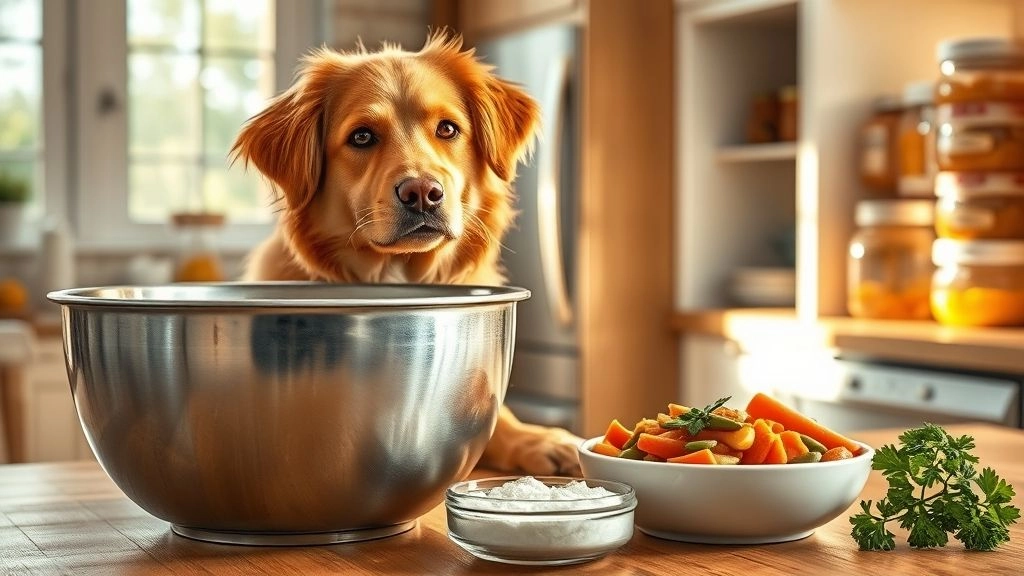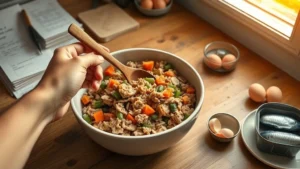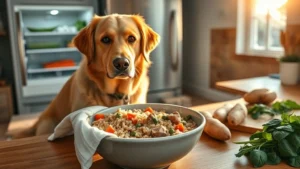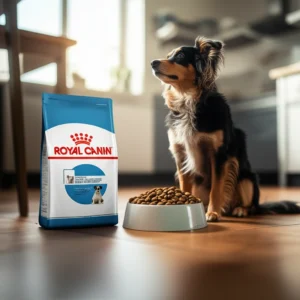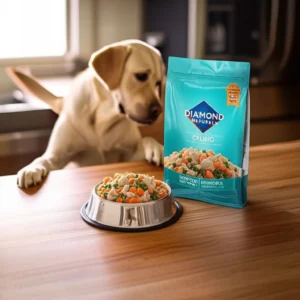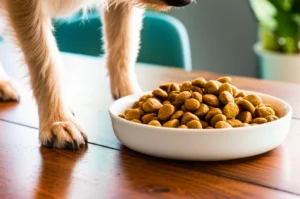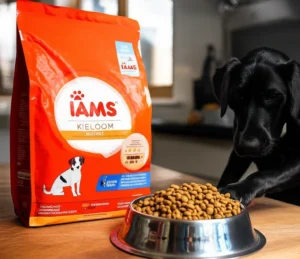Why Bother With Homemade?
What if I told you that you could feed your dog better and save real cash? That’s what got me hooked on this whole homemade dog food thing. I mean… have you seen the price tags on those “premium” kibbles lately? Ridiculous. There’s this rush you get when you whip up a big old pot of food for your pup and watch their whole body bounce at dinnertime. It’s like “Ha! Take that, big pet food companies.” (And, yes, your house will smell like a stew for hours, but trust me… worth it.)
But wait—before you get all iron-chef and start tossing leftovers into your dog’s bowl, let’s talk real quick. Because saving money is only a good deal if you do it right. Do it wrong, and you might end up with some pretty expensive vet bills—or a dog that just stares at dinner like you’ve lost your mind. Frugal isn’t frugal if your best friend’s health tanks.
Sneaky Savings, Real Risks?
Where Can You Save?
Okay, so homemade dog food sounds smart on the budget front. You use up sale meats, bulk rice, odd veggies—boom, homemade dog food ideas start paying off. I’ve personally gone months without buying a single bag of kibble… and honestly, I’ve never felt more smug at the dog park.
Let’s look at it side by side, just for fun:
| Food Type | Monthly Cost (50lb Dog) | Budget Hack |
|---|---|---|
| Premium Kibble | $60–$80 | Coupons if you’re lucky |
| Homemade (DIY) | $25–$40 | Buy bulk, freeze extras, use homemade dog food ideas |
| (Ouch) Vet Bills | $0… or $200+ | Balance nutrients from the start! |
But hang on—this only works if you nail the nutrition part. Mess it up, even a little, and your dog might start losing hair… or worse, energy. Been there. Trust me, frugal friends: you don’t want to learn the hard way.
The Nutrition “Puzzle”
Dogs Aren’t Little Humans. Wait, What?!
Raise your hand if you’ve ever thought, “If it’s good for me, it’s fine for my dog, right?” (Just me? Okay.) Here’s the twist: dogs aren’t quite like us when it comes to food. They need specific nutrients, not just “a bit of protein and some veggies.” The sciencey types say there are over 40 separate nutrients your pup needs on the daily according to canine nutrition advice.
Here’s what matters most—no jargon, promise:
- Protein: The main building block. Think chicken, beef, turkey, eggs, fish. Go for about 60% of the meal with lean cuts if you want to keep costs down (see expert breakdowns).
- Fat: Dogs love it; it fuels their playful zoomies. You want healthy fats—fish oil works, or even occasional flaxseed (not just bacon grease!).
- Carbs: Rice, oats, potatoes, and sweet potatoes. These fill tummies and keep dinner cheap, but not all dogs need tons of them. Mix it up; keep them happy.
- Vitamins and Minerals: Here’s where most of us go wrong. Dogs must get enough calcium, phosphorus, zinc, and vitamins from all those colorful veggies… but not just any scraps.
- Fiber: For easy potty time. Carrots, green beans, peas. Throw in bits from your own meal prep—no waste!
Have you ever noticed your dog acting a little “meh” after a meal? Sometimes it’s just a missing mineral, not a picky attitude. It took me forever to figure this out with my old lab, Daisy. She’d eat, then just flop. Swapped up the recipe—suddenly, she’s back stealing socks and running zoomies. Who knew?
Do You Need Supplements?
Short answer? Often, yes. No shame. You could do everything “right”—use a textbook recipe, buy grass-fed meats—and still miss a key vitamin or two. Most pros (and my local vet, shout-out to Dr. Morgan) say to add in a broad vitamin/mineral supplement or fish oil for omega-3s, even if you’re pretty sure. “Pretty sure” doesn’t cut it with man’s best friend!
Juggling all this sound wild? Don’t worry, there are tools like recipe calculators, but also so many balanced homemade dog food ideas available that save you time and mental load. Pick, prep, done.
No-Nonsense Recipe Building
What’s the Secret Recipe? (Not So Secret…)
Okay, so let’s build a basic, balanced meal—you don’t need to be a chemist. Here’s the general gist, based on research and what works in my house:
- 60–70% muscle meat (chicken, turkey, beef, or fish—whatever’s cheapest this week)
- 10–15% organ meat (liver, heart—cheap, and packed with good stuff)
- 10% veggies and fruits (carrots, spinach, apples—no grapes, though!)
- 10% bone or eggshell powder (Calcium’s a must for dogs—crush and sprinkle, super budget-friendly.)
- Healthy fat: Add a glug of fish oil or a dash of flaxseed oil right before serving.
Switch it up. Variety keeps your dog excited—and that’s more fun for you, too! Just… avoid onions, garlic, grapes, raisins, and macadamias. (We’ve all googled “why is my dog’s stomach making weird noises” at midnight, right?)
Hold Up—Puppies, Seniors, and Sick Dogs?
One thing: If your dog’s a puppy, a senior citizen, or has a health issue? Get a pro’s input. Their needs are, um, special. Don’t wing it! Puppies especially need tricky calcium-to-phosphorus ratios—my neighbor’s golden retriever pup learned this the hard way, and the poor little dude ended up with leg problems that cost a fortune to fix. No frugal wins there.
How Do I Make Sure My Homemade Dog Food Has All Nutrients?
Okay, But How Do You Know for Sure?
So, here’s the main event—the question we all desperately type at 2am: How do I make sure my homemade dog food has all nutrients?
First step, you gotta start with a recipe from someone who actually knows their stuff—a board-certified vet nutritionist or a scientifically trusted site. Not just “my aunt’s dog’s cousin’s favorite treat.” Sorry, Aunt Barb! Research like the studies found at UC Davis shows that even some vet-written recipes aren’t always spot-on according to updated veterinary advice.
Next, pick recipes that include those all-important percentages—protein, fat, carbs, calcium, and so on. If in doubt, sites like Balance.it can build a recipe for your dog’s weight and quirks. Print that out. Put it on your fridge. Ignore it at your own risk (I learned … oops).
Real-Life Check: Watch and Adjust!
No dog is a robot. Watch their body! Here’s what to do:
- Weigh your pup weekly (use the bathroom scale and do the math—yes, you holding a squirming Great Dane is comedy gold).
- Watch their coat—shiny and soft? Good. Dull and brittle? Time to tweak the recipe.
- Energy—if they’re snoozing more than usual, something might be missing.
- Poo patrol (sorry)—loose stool or constipation? Might need more fiber or a different fat.
- If you see persistent issues, or sudden changes, grab your vet. Seriously, they’ve seen it all—don’t be embarrassed.
I once tried a super “trendy” recipe off a random blog… let’s just say, three days in, my dog’s energy tanked and his tummy was all kinds of unhappy. An emergency call to my vet, a tweak with extra fish oil and a supplement, and poof—problem solved. Lesson learned. Pay attention; your pup will give you clues.
Keep Costs Down—Not Nutrition
Where to Cheat and Where NOT To
Here’s a fun fact: mixing in lower-cost grains like brown rice or oats can stretch your dog food budget big time. But—don’t overdo it. Dogs do better when animal protein is the star, but a little carb helps fill those big, hungry bellies. Especially if you’re experimenting with homemade dog food ideas that use leftovers or seasonal veggies.
Instead of buying pricey supplements at pet stores, ask your vet about generic versions, or use food-based options. For calcium, blend up clean eggshells in your coffee grinder. Pumpkin (the canned, unsweetened kind) is fantastic for fiber and digestion—a frugal lifesaver. Also, switching up meat types (even sometimes using canned mackerel) keeps things budget-friendly and nutrient-rich.
Remember, balance over time is what matters. If one meal is a little heavier on rice because you’re short on meat? No biggie, as long as it’s not every night.
Pitfalls Even Frugal Geniuses Make
- Skipping organ meat—don’t! Liver is a powerhouse and cheap.
- Forgetting fats—dogs need more than just lean chicken breast, add fish oil/salmon or a dab of coconut oil.
- Feeding only what “looks healthy”—kale isn’t a miracle for dogs and too much may upset tummies.
- Trying to “eyeball” vitamins/minerals. Be smarter than me and get that supplement, just in case.
We all goof now and then. The important part—learn and keep going.
Small Stories, Big Wins
You Don’t Have to Be Perfect
Confession: the first time I made a huge batch with sweet potato, turkey, and carrots, I got emotional like… is this what adulting feels like? My dog licked his bowl clean, then looked at me as if to say, “Okay, now try again. This one could use more flavor.”
With every batch, you’ll get better—spend less, waste less, and read your dog’s signals more easily. You’ll probably also end up Googling weird things, texting your vet for reassurance, and sharing new tip-offs with your friends. That’s the fun of it. You, my friend, are not just saving money and avoiding creepy additives—you’re serving up pure love, one scoop at a time.
Want even more budget-friendly tips and variety? Check out these frugal homemade dog food ideas—trust me, your wallet (and your dog’s belly) will thank you.
Wrapping It Up: Frugal Feeds, Happy Dogs
If you’ve made it this far, you’re already the kind of person who eats peanut butter on toast so you can treat your dog to something better. I see you, and you’re awesome. Homemade dog food can absolutely be a smart, thrifty move—if you pay attention to the details. That means starting with a pro-approved recipe, watching your dog’s body and energy, and not skimping on those vital nutrients.
You’ll stumble… we all do. But honestly? The reward is a bouncier, shinier, and possibly longer-lived best friend—without the premium price tag. So next time Fido’s dinner bell rings, smile knowing you’re giving something truly special (and budget-friendly). What recipe are you itching to try? Share your pantry wins or your “oops” moments—let’s eat better, save more, and wag onward!

